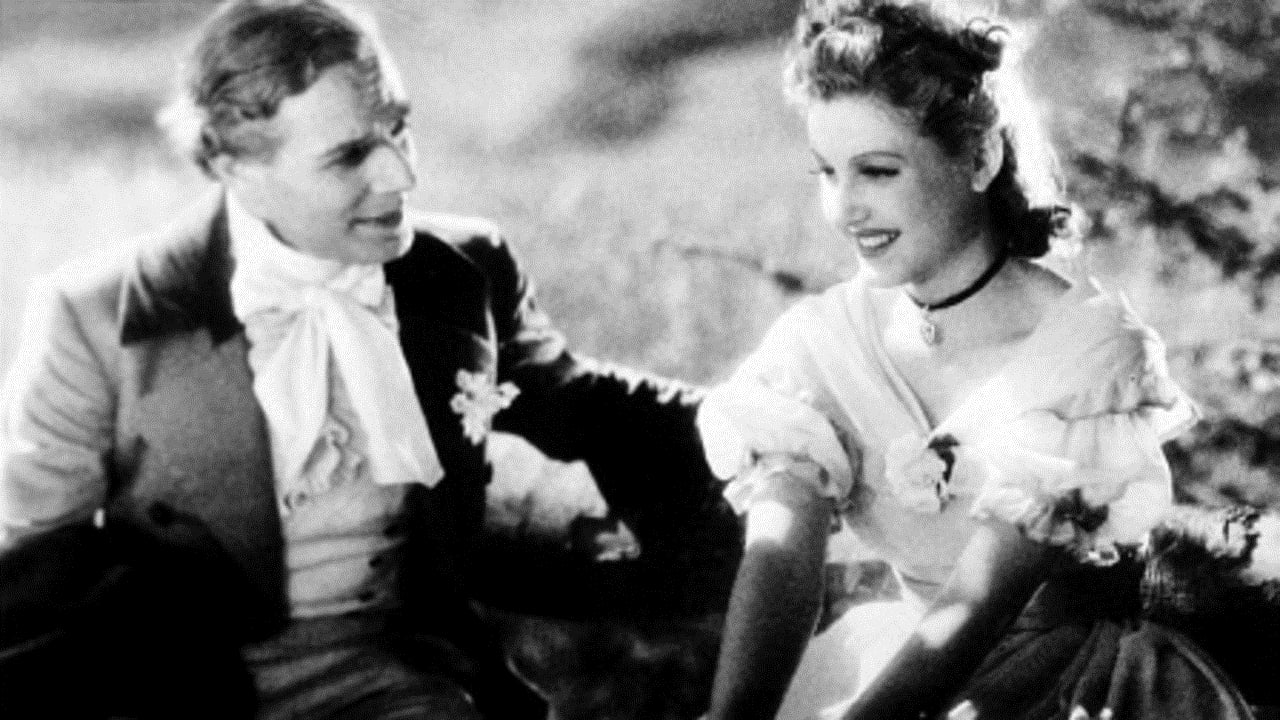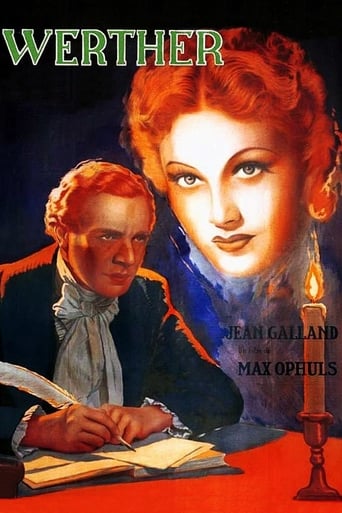ManiakJiggy
This is How Movies Should Be Made
Stometer
Save your money for something good and enjoyable
Portia Hilton
Blistering performances.
Abegail Noëlle
While it is a pity that the story wasn't told with more visual finesse, this is trivial compared to our real-world problems. It takes a good movie to put that into perspective.
morrison-dylan-fan
Although I've heard about him for years,I've constantly run into trouble when attempting to see a work from auteur Max Ophüls,from a power cut bringing my internet down,to two DVD players refusing to play his movie! Taking part in a French Challenge on ICM,I started looking for movies to view for the event,and stumbled upon a rare Ophüls title online,which led to me crossing my fingers,and opening this Werther's original.The plot:Arriving to a new town to be a magistrate, Werther finds his life to be at a satisfactory place,where he is treated respectfully at work,and his poems and violin compositions are received with praise. From the moment he sees Charlotte, Werther finds himself falling in love for the first time. Writing a special sonnet just for Charlotte,Werther soon discovers that his own sonnet has a tragic final verse. View on the film:Filming a classic German novel in France due to the build up to WWII taking place in Germany,co-writer/(with Hans Wilhelm and Fernand Crommelynck) director Max Ophüls sows silk Melodrama with the lavish stylisation of the Wiener Filme. Tracing Charlotte's footsteps with elegant tracking shots being swept across entire rooms, Ophüls gives Werther's love for Charlotte a texture of impending Melodrama darkness,via the light Charlotte brings into Werther's life being covered with deep shadows of misery that seep into Werther.Tragically dying in 1941 at just 19 years old from typhoid, Annie Vernay gives an utterly enchanting performance as Charlotte,whose concern and care for Werther is expressed in a fragile manner that Vernay holds back from blossoming into the love that Werther desires. Reuniting with Ophüls, Pierre Richard-Willm gives a splendid performance as Werther,whose arrival in town is given a charismatic swing by Willm,which Willm's snaps into brittle isolated,as the final pages from the novel of Werther are turned.
writers_reign
For many non-scholars this is probably one of the earliest Ophuls movies they will have encountered; he had made some sixteen films in Germany, France and Italy but tends to appear as a blip on the average viewer's radar with the 1939/40 Mayerling with Edwige Feuillere then appear permanently with Letter From An Unknown Woman in 1948 and everything that followed both in America and France. This is his take on Goethe and I resisted the temptation to summarize it as Getting Goethe's Garter. Even today it's not obligatory to adapt a novel faithfully and in 1938 there was an even more cavalier approach so that Ophuls thinks nothing of advancing the time-frame of the original and shifting the focus of attention from Werther to Charlotte though neither diminish the original unless, of course, you're a purist. We don't get too much of the celebrated 'circular' camera movements that tend to define Ophuls but he does indulge in dissolves, super-impositions and tracking shots and forges consistent links between Music and Visuals, inded Charlotte's love of and reaction to Music seems to take precedence over Werther's heartbreak but again in the context of the kind of film Ophuls has made this works. On a basic level the plot is menage a trois-lite; Werther arrives in a new town to take up a post in local government though his personality -carefree, poetic - is at odds with his career path. He bonds with his immediate supervisor, Albert, despite their contrasting personalities and when Albert leaves town on business Werther meets and falls in love with Charlotte who is engaged to Albert, a detail she omits to mention as she reciprocates Werther's feelings. With Werther in mid-proposal she finally confesses, feeling bound by honour more than love. She marries Albert, Werther turns to drink and whores and it all ends in tears. Not exactly Citizen Kane but Ophuls brings his artistry to bear and extracts a magical performance out of seventeen year old Annie Vernay (who was to die tragically three years later after contracting typhoid) who is saddled with that most thankless of roles the 'decent' person who adheres to a moral code even if it means sacrificing happiness. Like the man said this is definitely worth a look.
dreverativy
The "Sorrows of Young Werther" (1774), a rather hapless and excessively emotional law clerk, is often thought of as the first great German novel. Whether it is or isn't is not important. What is important is that Goethe's epistolary work (no doubt influenced by Samuel Richardson and Laurence Sterne, though probably not Tobias Smollett) had a monumental impact on the development of German romanticism, and on the development of a poetry of feeling, of 'sturm und drang'. It impacted upon almost all forms of humanist endeavour: drama (especially during the 1770s through the work of Lessing), poetry, theology (still the queen of the sciences in late eighteenth century Germany), history, and other categories of belles-lettres. It exploded on the continental literary scene and vaulted its author to the status of a superstar. Thousands of young men committed imitative suicide, and Napoleon kept a copy in his knapsack.Werther is supposed to have been, like Goethe himself, a junior clerk in the Reichskammersgericht (the imperial supreme court) based in the free upper Rheinish city of Wetzlar. Lotte is essentially Charlotte Buff, Goethe's lost love (in this instance a decent performance by the delightful Annie Vernay).The story is very well known, and there is no need to repeat any of the details. Pierre Richard-Willm, often derided as rather stiff and wooden is exactly right for this eponymous role. He has a rather vague and abstracted appearance that subverts his looks (he was probably rather old for the part, but gets away with it). The audience can easily scent a loser. In Adam von Hochatten (Jean Galland) we can detect a winner, secure in his status and prospects.Werther gets lost in drink and in an obsession with James Macpherson's forgery of Ossian. Max Ophuls carries us away in in a state of emotional and romantic resignation and despair to the music of (variously) J. S. Bach, W. F. Mozart, Beethoven, Schubert (very apt, Beethoven and Schubert), and Haydn. The costumes are well done (if a little anachronistic), as is the art direction. Ophuls is able to convey an authentic feeling - if not for 1774, then perhaps 1804. We have for instance a scene with a slightly fustian grand duke (Phillippe Richard), and we are reminded that the old Germany was a mosaic of innumerable petty principalities. Some critics, notably Richard Roud, accused Ophuls of vulgarising this supreme novel. That was perhaps inevitable in any cinematic adaptation. However, this is a very fine effort. The most curious thing is why France was making a film of the Great German Novel at all, and particularly in 1938?
Mario TSR
This was Ophuls rendering on film of Goethe's classic. Although not the best of his work, the acting is quite good. The most remarkable aspects are the cinematography and the direction. There is a with very interesting use of lighting, with pools of light drawing attention to specific parts of the set and characters, more typical of theater than 30's cinema. But the direction uses others devices to avoid the "stagy" look, like the interposition of objects between the camera and the action to create depth, sometimes using deep focus. But that was shortly before Citizen Kane...

